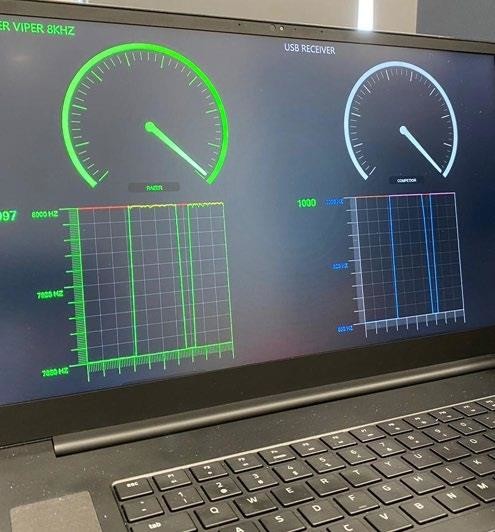A sneak peek at Razer’s breakthrough 8,000Hz polling rate technology.


Razer’s R&D team has been working on some really interesting stuff lately, and one of those projects was introduced to us by Lead Product Developer Ayush Sharma and Product Manager Ben Goh.
Their work-in-progress gaming mouse technology, which was demonstrated using this rather fancy machine you see here, allows them to introduce true 8,000Hz polling rates and ultra-low click latencies of 0.125ms in most, if not all their future top-end mice - that’s eight times better than the current industry best.
Oh, yes. For those who are about to Google “polling rate”, it basically refers to the frequency at which a device checks, or “polls” for inputs and positional changes, and it’s usually measured in hertz (Hz).
Now, this is really important in competitive gaming, especially in fast-paced shooters like Riot Games’ Valorant, where split-second responses might mean the difference between victory and defeat. Putting this into context, a mouse with a low polling rate might not pick up on the tiny adjustments you made to position your crosshair over an opponent’s head since it doesn’t report changes as often as one with a high polling rate. The result? You could end up missing the shot entirely, costing your team the round, or even the match.

POLLING RATE IS REALLY IMPORTANT IN COMPETITIVE GAMING, ESPECIALLY IN FAST-PACED SHOOTERS LIKE RIOT GAMES’ VALORANT, WHERE SPLIT-SECOND RESPONSES MIGHT MEAN THE DIFFERENCE BETWEEN VICTORY AND DEFEAT.

Additionally, you might also have noted our emphasis on “true polling rate”. But what’s the difference? In a nutshell, a true polling rate of 8,000Hz indicates that the device really is checking for changes 8,000 times each second. A regular mouse that claims to have a 2,000Hz polling rate might only be checking 1,000 times a second, but it duplicates the result once, leading to the supposed 2,000Hz.
Similarly, we were shown a sample taken from a test comparing the polling rates of a Razer prototype mouse against a generic gaming mouse (we weren’t allowed to take a photo of it, but let’s just say it belongs to the company’s competitor). The number at the top left of each graph signifies the polling rate in Hz, and as displayed, the prototype polls at 7,997Hz, almost eight times that of the generic gaming mouse, which polls at a flat 1,000Hz.
The key takeaway? It’s ultra-responsive, almost absurdly so. But the million-dollar question here is whether you actually feel a difference when you use it. According to the duo, the difference is perceptible - they had previously sent out prototypes to multiple esports athletes (primarily shooter players), and most, if not all of them reported significant improvements to input detection and responsiveness. How about us?
After spending a few days with the mouse in Valorant, I’m unfortunately inclined to say no. It’s possible that I simply don’t have the lightning-fast reflexes and keen senses of the world’s best players, but consider this – a mouse with a 1,000Hz polling rate has a response time of 1ms, and Razer claims to be able to reduce that by 8x to a mere 0.125ms. I have no doubt about these numbers, and they sure look impressive on paper. However, an 8x improvement in speed still translates to just a fraction of a second, and I seriously doubt that many gamers will be able to notice the difference.

IF YOU’RE LOOKING TO IMPROVE YOUR GAME BY UPGRADING YOUR MOUSE, THERE ARE THINGS THAT MATTER FAR MORE THAN ITS POLLING RATE.
In comparison, a 500Hz polling rate gives a response time of 2ms. This is double what you get on a mouse that polls at 1,000Hz, but having switched between both 500Hz and 1,00Hz mice, I am still unable to notice the difference. As far as I can tell, I play just as well on a mouse that polls at 500Hz, and things like size, shape and weight still matter far more when it comes to how good my aim is going to be. On top of that, while most professional players play at 1,000Hz, there are still a handful who resolutely stick to 500Hz. They appear to have no trouble staying at the top of their game with this either, which further supports the argument that polling rate actually doesn’t matter all that much.
In my time with Razer’s prototype, I’m almost sheepish to admit that the difference between it and a 1,000Hz polling rate – even a 500Hz one at that – is imperceptible. If you’re looking to improve your game by upgrading your mouse, there are things that matter far more than its polling rate.
Just as you don’t Need a 20,000DPI mouse, you probably don’t need one with an 8,000Hz polling rate. It’s an impressive specification to be sure, and credit goes to Razer for being the first to push the envelope and go where no other manufacturer has gone before. I don’t discount the fact that it could make a difference in one or two edge cases at the highest levels of competitive play and in the hands of the best players, but your average gamer is likely not going to see much benefit from it.
I’m not trying to take anything away from Razer here. With its implementation of other developments such as optical switches, 20,000DPI Focus+ optical sensor, and HyperSpeed Wireless tech, Razer makes some of the most advanced and technically competent gaming mice on the market today. It’s taken specifications that have been the industry standard for years and thrown them out the window, but we may simply be running up against the limits of what it is humanly possible to perceive.
Will I be picking up Razer’s 8,000Hz mouse when it releases? Maybe – but that will still depend on how comfortable I am with the mouse’s shape, which is really what you should be caring about.
By Kenneth Ang & Hoots the Owl
PICTURES RAZER, 123RF, DIGITAL IMAGING JASON TAN























